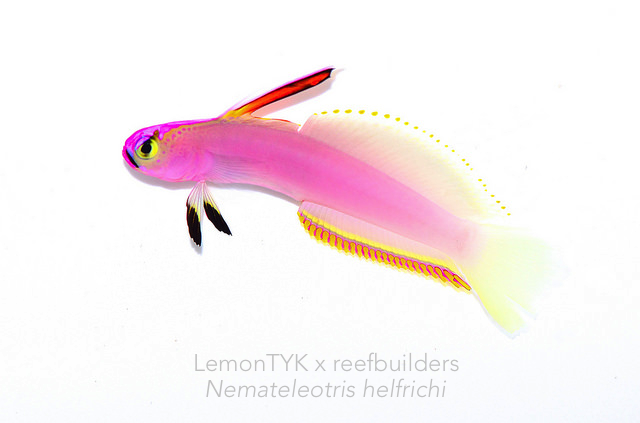Immense fish collection in the early 90’s brought new light to a plethora of colourful reef fish, many of which the world had never seen. In 1938, from a smorgasbord of specimens in the Albatross collection, one exquisite little fish was described and given a name. Nemateleotris magnifica, now known as the red fire fish or magnificent fire fish, was the first member of a genus that would one day serve to host one of the most charming and exquisite collection of ptereleotrine fish.

The prefix nemat comes from the Greek word that means thread, in reference to the filamentous first dorsal fin which all members in this genus possess. Once placed in Eleotridae, the genus is now correctly placed in the family Microdesmidae, under the subfamily Ptereleotrinae. Fast forward to 1973, the small genus Nemateleotris was reviewed and two additional members were described. N. decora and N. helfrichi would serve to become the 2nd and 3rd members of Nemateleotris. At the present day, the genus now currently contains four members, the newest addition being the Indian Ocean population of N. decora which as of 2013, has been elevated to full species status. It is now called N. exquisita.

With names like N. decora, N. magnifica and N. exqusita, it hardly comes as a surprise that all fire fishes are really wonderfully designed and coloured. It comes with little doubt why the genus to this day serves as one of the aquarium trade’s evergreen darlings. As decorated, magnificent and exquisite as the preceding three species appear however, it is ironically N. helfrichi that is most coveted and in the opinion of many, to be the most alluring.

N. helfrichi is an interesting member in which it holds two colour forms, a pink and a yellow form with both attaining different maximum developmental sizes as well (more on that later). Both are found in relatively deepwater of at least 40m (130ft), but can occur in depths exceeding 100m (300ft). Like all members of its genus, N. helfrichi is most often found in sandy rubble bottom where it is very often found as monogamous pairs. They flick the filamentous portions of their dorsal fins while hovering above their burrows, in which they quickly retreat into at the first sign of danger.

The type specimen for N. helfrichi was collected in the Society Island chain, more specifically Tahiti. The fish is rose-pink to lavender, fading to a lighter shade toward the caudal fin. All its fins are hyaline and tinted either in lavender or white. It possesses a filamentous “antennae” on the anterior dorsal fin, and the pelvic fins are tipped in black. A magenta stripe runs from the base of its dorsal filament downward between the eyes and ends at the chin, with a black stripe on its upper lip and another just above its eye.
The black markings on the eye and upper lip gives the fish a “moustached meet eyeliner” appearance that is quite comical.

This of course, comes as a rather unfamiliar sight when one mentions “helfrichi fire fish”. What we’re accustomed to seeing is one with a yellow head, a more common and widespread form that graces the aquarium trade ever so often. We will get to that later. Unfamiliar as it may be, it is the “true” helfrichi fire fish namely because it was used as the holotype for the description of the species.
The pink headed N. helfrichi is a rare and very expensive offering in the aquarium trade, and is collected most often from the Cook Islands. Apart from there, it can be found in Tahiti and probably other locations within the Society Islands as well. Unlike the yellow-headed forms, the true to type N. helfrichi is very much more robust and attains a larger maximum size.

Above is the more widespread yellow headed variety which is often collected out of the Marshall Islands. It can be found elsewhere in the Pacific Ocean as well, from Tuamotu up to the Ryukyus. This form differs chiefly in its coloration, with the head being coloured yellow instead of pink. It still possesses the magenta stripe that starts from the dorsal fin, but stops between the eyes and does not run beneath it to the chin. It also lacks the black markings above the eye and on the upper lip which the type species bears.
Seeing as how both forms are so different in both morphology and colour, it is very likely that the more widespread yellow-headed form could eventually be separated from N. helfrichi. Additionally, both are not sympatric and do not overlap where they occur, which is another likely candidate for subspecies or species allocation.

With N. decora being known for decades but only just recently had its Indian Ocean form separated, it is quite likely that N. helfrichi could possess two species as well. Perhaps in future it will follow suit and the yellow headed variety that we’ve all come to know and love would have a new name. To continue with the naming trend with regards to the specific epithet, maybe Nemateleotris elegans or N. grandiose could be fitting. Perhaps even N. splendida.
Whatever it is, or whatever the outcome, at least now you know that the “helfrichi fire fish” everyone has been so forward in naming, actually truly belongs to the much rarer pink-headed moustache growing eyeliner wearing Cook Island form.



